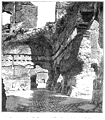Thermae
(
θέρμαι, literally “hot-springs”). The
name given by the Romans to the public buildings, founded in and after the time of Agrippa,
which combined, with warm baths, the arrangements of a Greek gymnasium. These included open
and covered colonnades for conversation, instruction, and different exercises, especially the
game of ball. The most extensive and splendid establishments of the sort were to be found in
Rome, and are still to be seen, though, for the greater part, in ruins. Of the existing
remains the most important are those of the Thermae of Caracalla. These accommodated some 1600
bathers
 |
|
Remains of the Thermae of Caracalla. (From a photograph.)
|
at once, but were inferior in size to the Thermae of Diocletian on the Quirinal
Hill, which were built for the use of 3200 bathers. Of these there are extensive remains,
including part of a theatre. The Thermae of Diocletian were dedicated in A.D. 350. See
Balneae.





